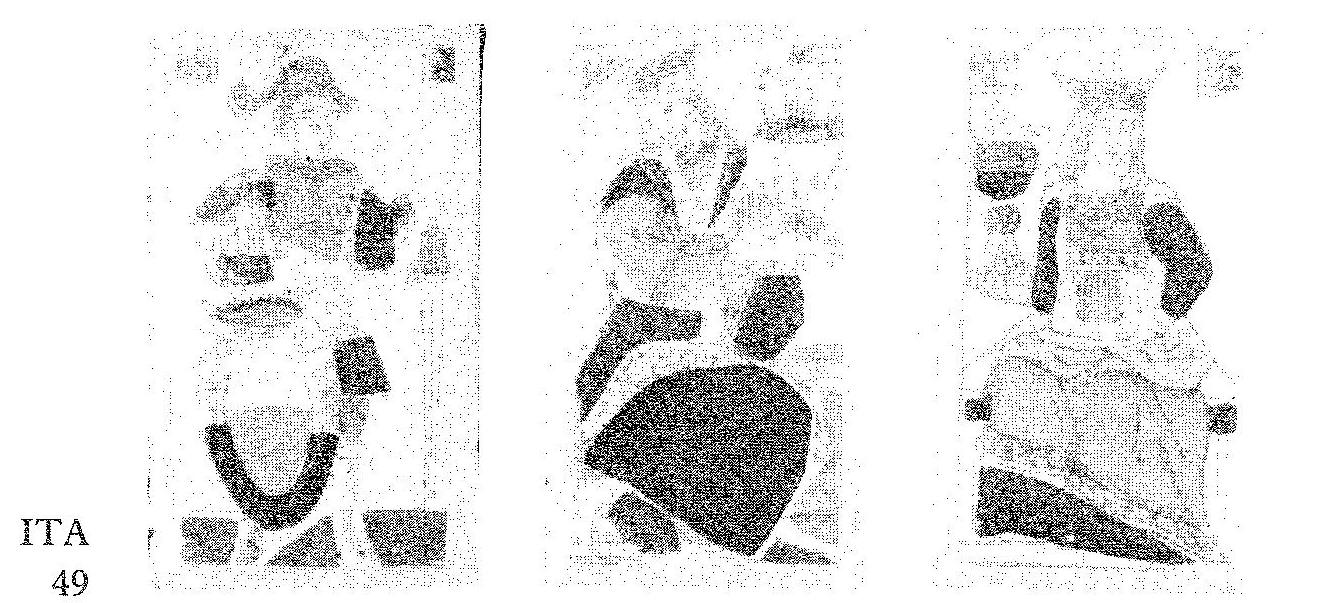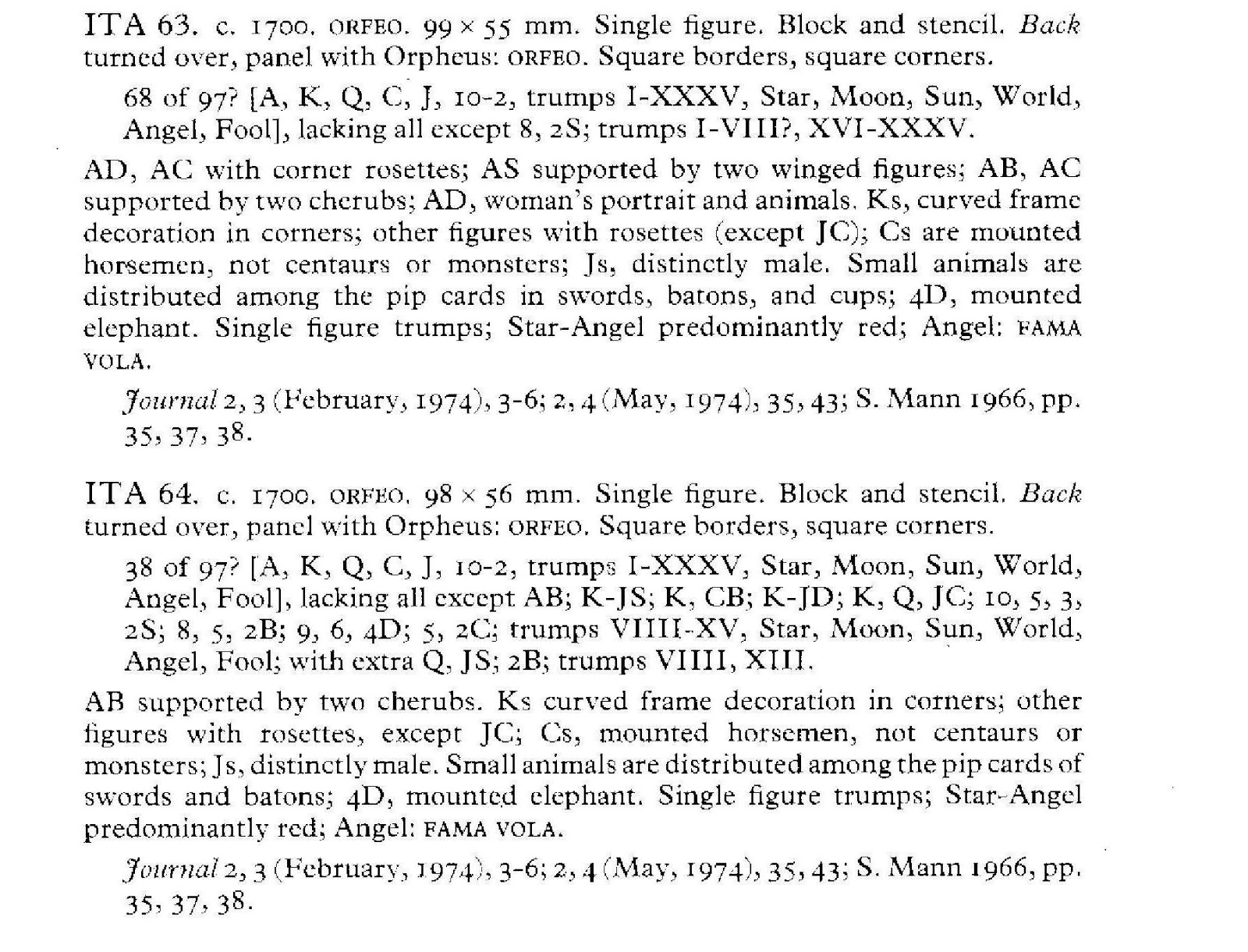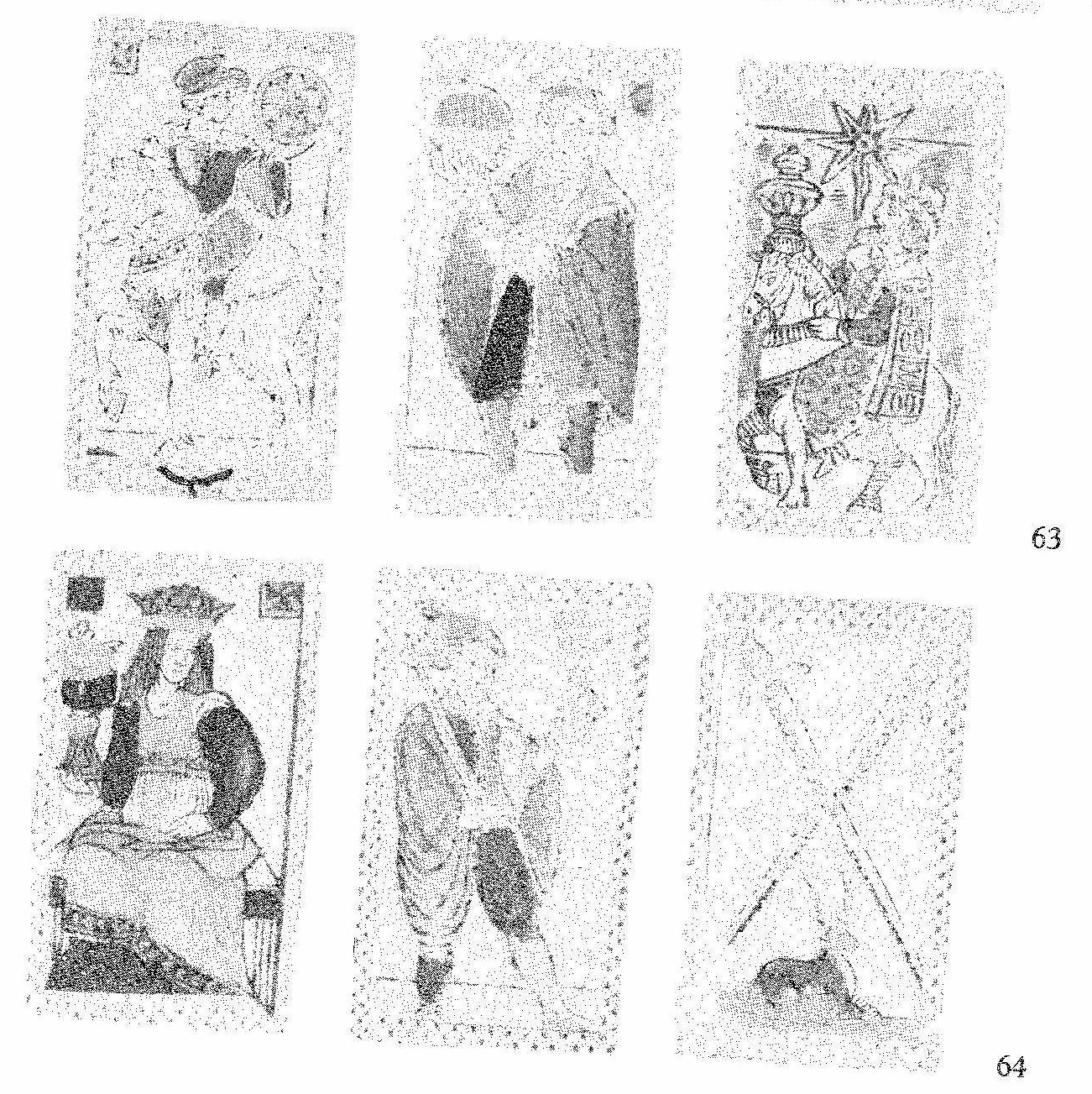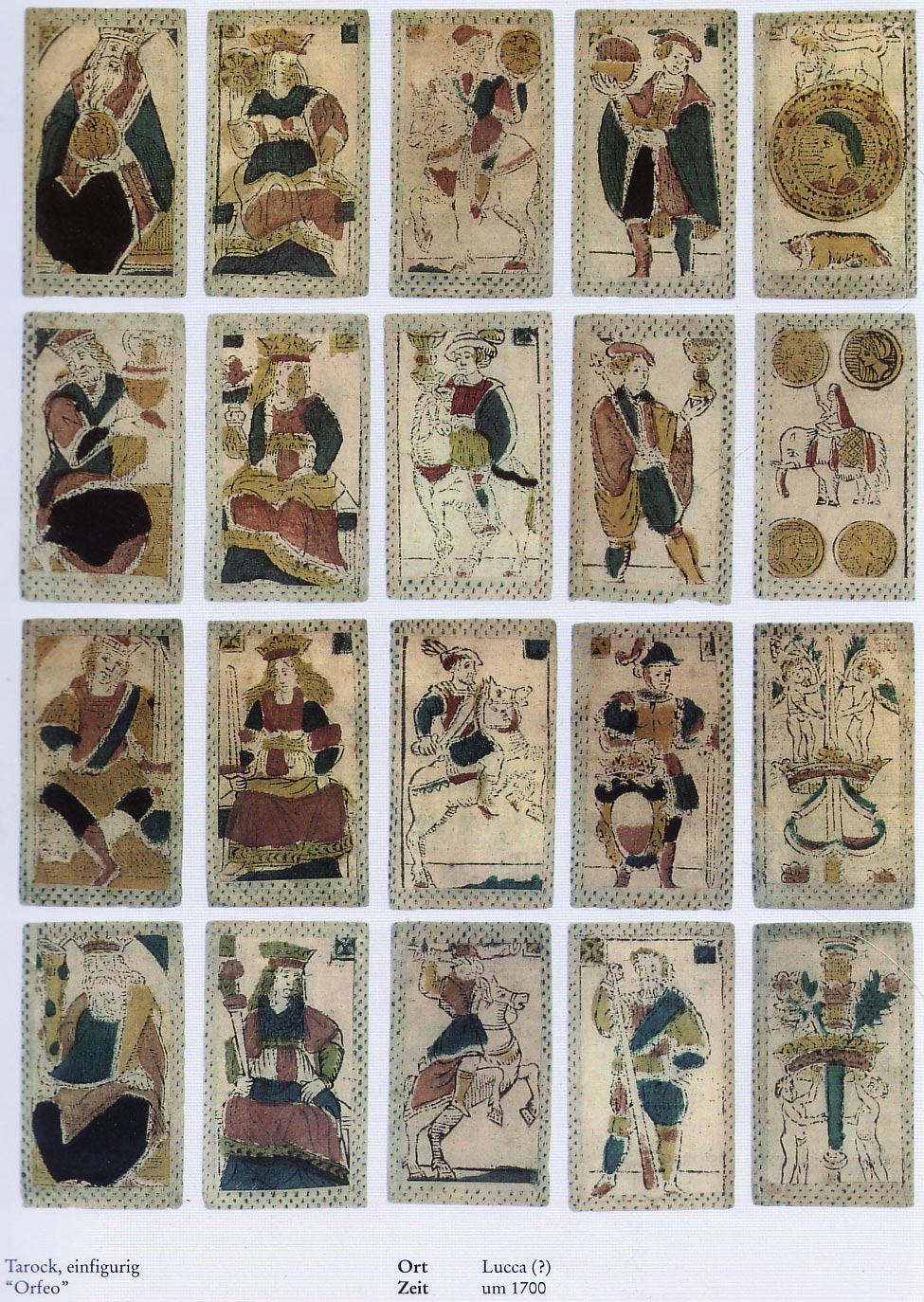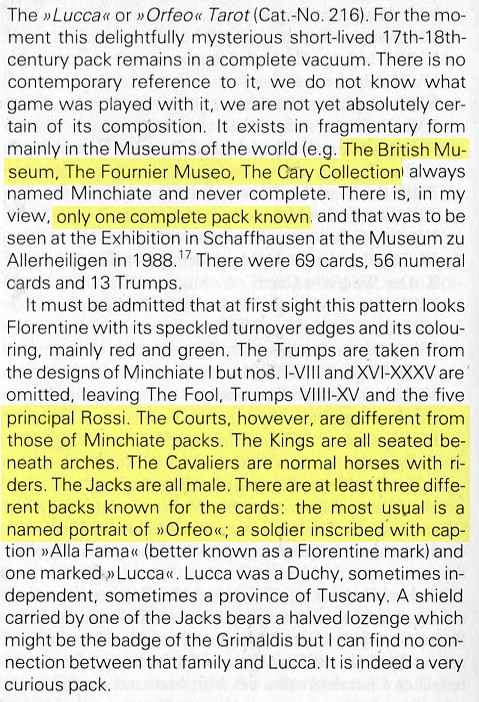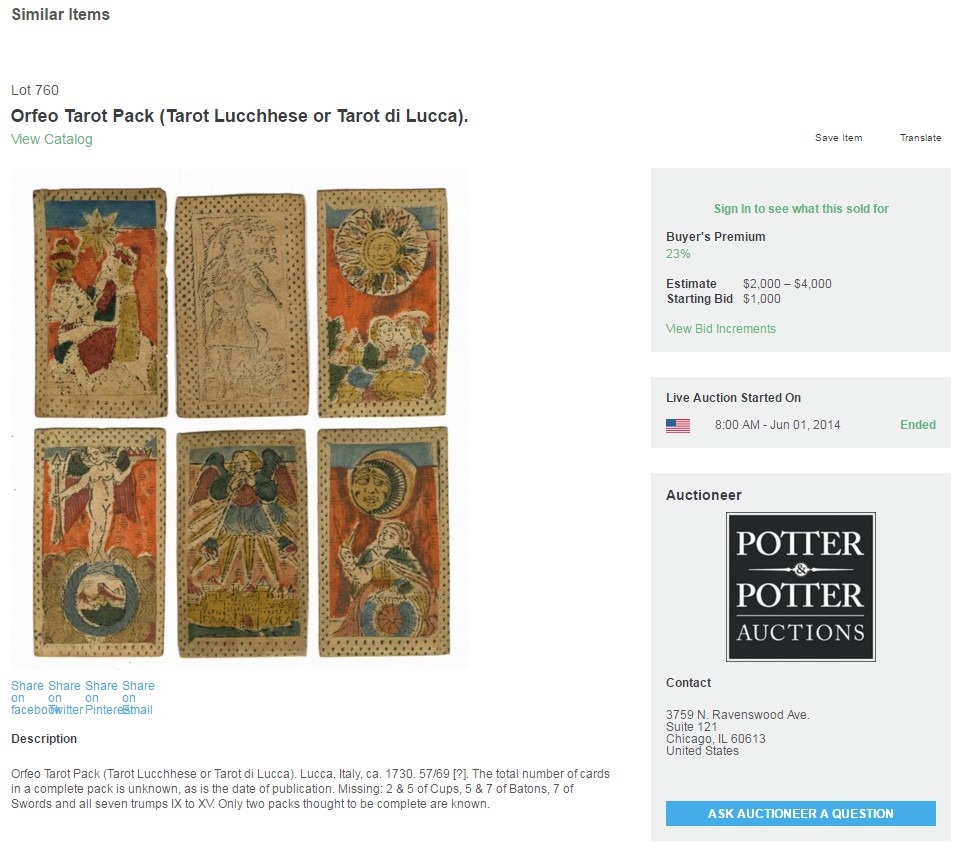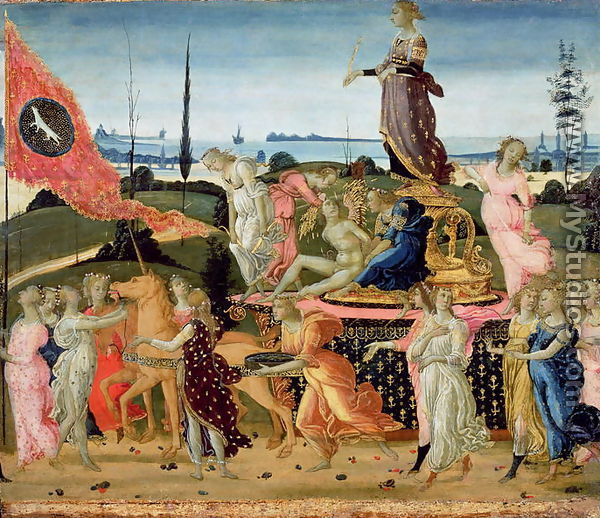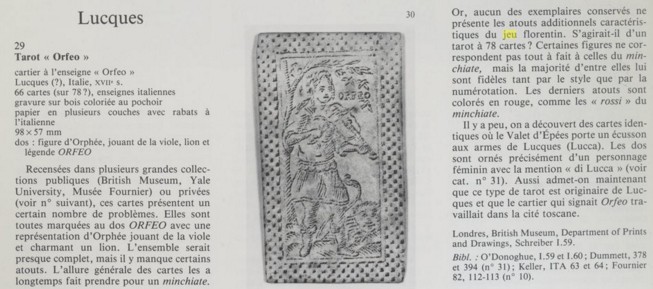An article in The Playing Card for Oct.-Dec. 2017, pp. 65-747 "The Orfeo Conundrum" by Giobattista Monzali, sheds some new light on these cards. especially in regard to the dating--and also, along the way, the manufacturer. In addition, he distinguishes between two types of "Orfeo" decks: those that definitely are minchiate and those that might be tarocchi. He also makes a nice observation about the woodblocks used in the two cases but does not draw any conclusions from that.
Packs are called "Orfeo" packs because several of them show Orpheus on their backs; but they also include packs with "alla fama" and "d'Lucca" backs (images on p. 66). These packs share some things tying them to Lucca: the Lucca skyline on the "Trombe" card, as opposed to that of Bologna or Florence; also two horizontal bands on the 2 of Coins (in the "Orfeo" minchiate decks), which seems to be unique to Lucca (images p. 70); and the pages of Swords have the coat of arms of Lucca (images p. 67)
One mystery about these decks, or rather some of them, is whether they are minchiate or tarocchi, and if tarocchi, how many cards in the deck On the latter, Dummett in 1993 speculated that there were 69 cards in all; see viewtopic.php?f=11&t=1019&p=15181&hilit=Orfeo#p15181, In 1981 he had argued for 78, at http://askalexander.org/display/22525/T ... 5?pw=orfeo. Why did he change his mind? All I can think of is the fact that no decks have been discovered in the interim that have any of trumps I-IX and are not clearly minchiates. This continues to be true.
Another mystery is when they were made, i.e. whether in the 18th century or as early as the 17th. On this one Manzoni makes a real contribution.
For the dating, Monzali compares certain cards of a known Lucca minchiate deck (with a geometric pattern on its back (shown on p. 68 ) with those of an "Orfeo" minchiate deck (not one of those that might be a tarocchi, however). They are very similar except for the writing on the cards, which appears to identify the card maker. The Lucca minchiate without one of the three backs characteristic of the "Orfeo" packs has on its 2 of Cups the name "SANTI" plus the initials F and G. The 5 of Cups has the initials S, F, and G. Trump XXIIII (Libra) has on it "SANTI" on one line, then "G" with space for more letters which may have come off, then on the next line "NELLI". The "Orfeo" minchiate has on its 2 of Cups the letter "F". The 5 of Cups has the initials S, F, and G. Nothing can be read on the Libra card (all shown on p. 69).
Monzali recalls (p. 68) that in March of 1996 Franco Pratesi had published a list of the holders of the concession to collect the taxes on playing cards in Lucca. The name of Santi Giovannelli appears on this list for 1722-1724 and later as Santi Felice Giovannelli from 1727-1745,when he is replaced by someone else.. Franco's list had no names for 1725-1727, So the "Orfeo" minchiate can be dated to 1722-1745.
Monzali also clarifies a few things that previous writers had not gone into. Of the Orfeo packs, as I mentioned, some are clearly minchiates, because they have the standard female pages in coins and cups and centaur knights of minchiate (shown pp. 72 and 73), as well as cards unique to minchiate. There is one "Orfeo" deck from the 2006 auction of the Kaplan collection, which has trumps III, IV, V, VI, and VIII (thus far missing from the type with tarocchi-style pages and knights), but also XXIIII-XXVIII, XXX, and XXXIIII (p. 65), which make it clearly a minchiate (he does not say what the pages and knights look like.; presumably they are mnchiate-style). There is also, brought to the attention of the IPCS in 2014, an "alla fama" deck done by Giovannelli in a museum in Lucca that is a complete minchiate (p. 68). And more recently another Giovannelli minchiatw has "been detected" (p. 68), which is the deck he uses to argue for Giovannelli's production of the possibly non-minchiate decks. He does not say, that I can find, whether this deck has any of trumps I-VIII.
As many have noted, the problematic "Orfeo" decks have all-male pages and mounted knights, suggestive of tarocchi (shown same pp. ). The Fool and Aces are also different from minchiate's (added later: the "Orfeo" can be seen in a post by Huck at viewtopic.php?f=11&t=975&p=14940&hilit=orfeo#p14945), and for these decks none of the cards unique to minchiate are extant. These facts speak in favor of their being tarocchi.
On the other hand, most of the existing designs, other than those mentioned, are precisely those of minchiate. Also, Franco could find no records of tarocchi produced in Lucca, only minchiate, whether for export or local consumption, during this time (p. 76). Also, the numbering of the triumphs is precisely that of minchiate, at least for the 12 extant ones plus the Fool. No known tarocchi has precisely that order.
If tarocchi, then how many triumphs, given that none of the triumphs below IX the Wheel is extant? For comparison, here is Dummett's list of A-type trump orders, from his 1980 Game of Tarot:
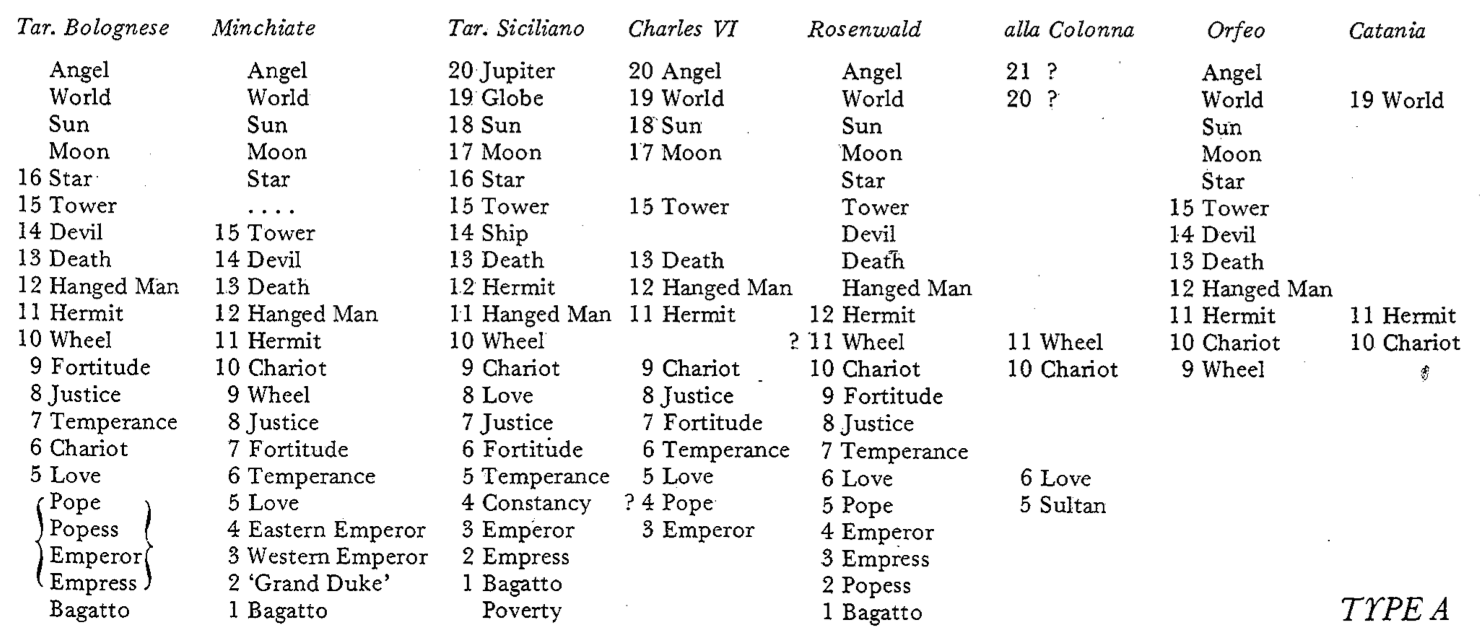
Both issues, whether the problematic packs are tarocchi or minchiate, and how many cards in these packs, remain unresolved. Monzali says (p. 76),
I cannot find in his article anywhere he has shared with us his reasons for such unhappiness with the 69 card alternative..Weighing I would give two-third to the first option (Minchiate pack) and one-third to second one (Tarot pack). However, I am not happy at all with the reconstruction of a pack of 69 cards suggested by Sylvia Mann.
The nice point about the woodblocks is that Monzali notices (p. 75) that the "Orfeo" minchiate decks seem to use the same woodblock as the non-Orfeo minchiates of Lucca, but with more wear, but the possibly tarocchi decks use new woodblocks. What is to be gained from this information is not clear. However it does rule out one speculation that Dummett had in 1980 (which I put in bold below; copied from Game of Tarot Ch. 20, at viewtopic.php?f=9&t=1175&p=19235&hilit=Orfeo#p19235):
My only criticism of the article is that, while being more complete than anything else, it should have been a bit more more complete. In particular, does the Kaplan collection deck have minchiate knights and pages, or tarocchi ones? He doesn't say, that I can find. Perhaps it is assumed without checking. And does the Lucca minchiate in his possession have any of trumps I-VIII? Do we need to allow for the possibility of a third type of Lucca pack, one with the cards unique to minchiate but without any trumps below VIIII. I hope not. Also, if he is going to reject the 69 card hypothesis, he should tell us why.Perhaps the designs used were not at that time regarded as the exclusive property of the Minchiate pack, which had probably taken them over, at the time of its invention in the previous century, from some local standard pattern for the normal Tarot pack; or, possibly, the cardmaker using the sign Orfeo found it more economical to use Minchiate blocks, so far as he could, to produce ordinary 78-card Tarot packs.
I hesitate to reproduce the images here, because all of them, the article says at the end, are from the author's private collection. The Playing Card now has a pdf electronic edition for $16 a year, or 12 pounds Sterling, The print edition is 30 pounds and up, which besides the current volume also gives access to back issues via "Ask Alexander", and other things. See https://i-p-c-s.org/subs/join.php for more information.
Merry Christmas to everyone.
Added later: For nice images of "Orfeo" cards, see Huck's post at viewtopic.php?f=11&t=975&p=14940&hilit=orfeo#p14945



